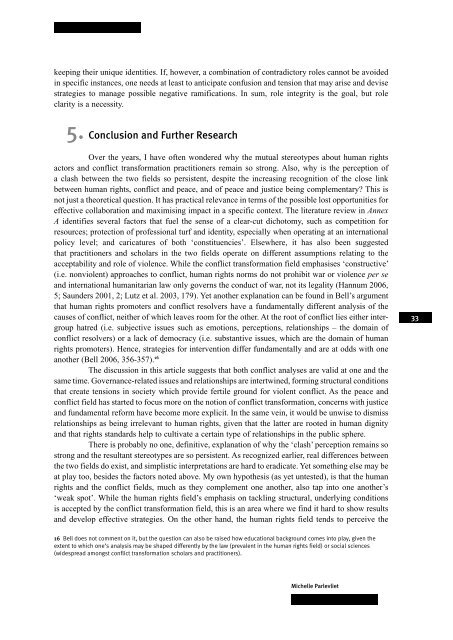Human rights and conflict transformation: The challenges of just peace
Human rights and conflict transformation: The challenges of just peace
Human rights and conflict transformation: The challenges of just peace
Create successful ePaper yourself
Turn your PDF publications into a flip-book with our unique Google optimized e-Paper software.
keeping their unique identities. If, however, a combination <strong>of</strong> contradictory roles cannot be avoided<br />
in specific instances, one needs at least to anticipate confusion <strong>and</strong> tension that may arise <strong>and</strong> devise<br />
strategies to manage possible negative ramifications. In sum, role integrity is the goal, but role<br />
clarity is a necessity.<br />
5. Conclusion <strong>and</strong> Further Research<br />
Over the years, I have <strong>of</strong>ten wondered why the mutual stereotypes about human <strong>rights</strong><br />
actors <strong>and</strong> <strong>conflict</strong> <strong>transformation</strong> practitioners remain so strong. Also, why is the perception <strong>of</strong><br />
a clash between the two fields so persistent, despite the increasing recognition <strong>of</strong> the close link<br />
between human <strong>rights</strong>, <strong>conflict</strong> <strong>and</strong> <strong>peace</strong>, <strong>and</strong> <strong>of</strong> <strong>peace</strong> <strong>and</strong> <strong>just</strong>ice being complementary? This is<br />
not <strong>just</strong> a theoretical question. It has practical relevance in terms <strong>of</strong> the possible lost opportunities for<br />
effective collaboration <strong>and</strong> maximising impact in a specific context. <strong>The</strong> literature review in Annex<br />
A identifies several factors that fuel the sense <strong>of</strong> a clear-cut dichotomy, such as competition for<br />
resources; protection <strong>of</strong> pr<strong>of</strong>essional turf <strong>and</strong> identity, especially when operating at an international<br />
policy level; <strong>and</strong> caricatures <strong>of</strong> both ‘constituencies’. Elsewhere, it has also been suggested<br />
that practitioners <strong>and</strong> scholars in the two fields operate on different assumptions relating to the<br />
acceptability <strong>and</strong> role <strong>of</strong> violence. While the <strong>conflict</strong> <strong>transformation</strong> field emphasises ‘constructive’<br />
(i.e. nonviolent) approaches to <strong>conflict</strong>, human <strong>rights</strong> norms do not prohibit war or violence per se<br />
<strong>and</strong> international humanitarian law only governs the conduct <strong>of</strong> war, not its legality (Hannum 2006,<br />
5; Saunders 2001, 2; Lutz et al. 2003, 179). Yet another explanation can be found in Bell’s argument<br />
that human <strong>rights</strong> promoters <strong>and</strong> <strong>conflict</strong> resolvers have a fundamentally different analysis <strong>of</strong> the<br />
causes <strong>of</strong> <strong>conflict</strong>, neither <strong>of</strong> which leaves room for the other. At the root <strong>of</strong> <strong>conflict</strong> lies either intergroup<br />
hatred (i.e. subjective issues such as emotions, perceptions, relationships – the domain <strong>of</strong><br />
<strong>conflict</strong> resolvers) or a lack <strong>of</strong> democracy (i.e. substantive issues, which are the domain <strong>of</strong> human<br />
<strong>rights</strong> promoters). Hence, strategies for intervention differ fundamentally <strong>and</strong> are at odds with one<br />
another (Bell 2006, 356-357). 16<br />
<strong>The</strong> discussion in this article suggests that both <strong>conflict</strong> analyses are valid at one <strong>and</strong> the<br />
same time. Governance-related issues <strong>and</strong> relationships are intertwined, forming structural conditions<br />
that create tensions in society which provide fertile ground for violent <strong>conflict</strong>. As the <strong>peace</strong> <strong>and</strong><br />
<strong>conflict</strong> field has started to focus more on the notion <strong>of</strong> <strong>conflict</strong> <strong>transformation</strong>, concerns with <strong>just</strong>ice<br />
<strong>and</strong> fundamental reform have become more explicit. In the same vein, it would be unwise to dismiss<br />
relationships as being irrelevant to human <strong>rights</strong>, given that the latter are rooted in human dignity<br />
<strong>and</strong> that <strong>rights</strong> st<strong>and</strong>ards help to cultivate a certain type <strong>of</strong> relationships in the public sphere.<br />
<strong>The</strong>re is probably no one, definitive, explanation <strong>of</strong> why the ‘clash’ perception remains so<br />
strong <strong>and</strong> the resultant stereotypes are so persistent. As recognized earlier, real differences between<br />
the two fields do exist, <strong>and</strong> simplistic interpretations are hard to eradicate. Yet something else may be<br />
at play too, besides the factors noted above. My own hypothesis (as yet untested), is that the human<br />
<strong>rights</strong> <strong>and</strong> the <strong>conflict</strong> fields, much as they complement one another, also tap into one another’s<br />
‘weak spot’. While the human <strong>rights</strong> field’s emphasis on tackling structural, underlying conditions<br />
is accepted by the <strong>conflict</strong> <strong>transformation</strong> field, this is an area where we find it hard to show results<br />
<strong>and</strong> develop effective strategies. On the other h<strong>and</strong>, the human <strong>rights</strong> field tends to perceive the<br />
16 Bell does not comment on it, but the question can also be raised how educational background comes into play, given the<br />
extent to which one’s analysis may be shaped differently by the law (prevalent in the human <strong>rights</strong> field) or social sciences<br />
(widespread amongst <strong>conflict</strong> <strong>transformation</strong> scholars <strong>and</strong> practitioners).<br />
Michelle Parlevliet<br />
33

















